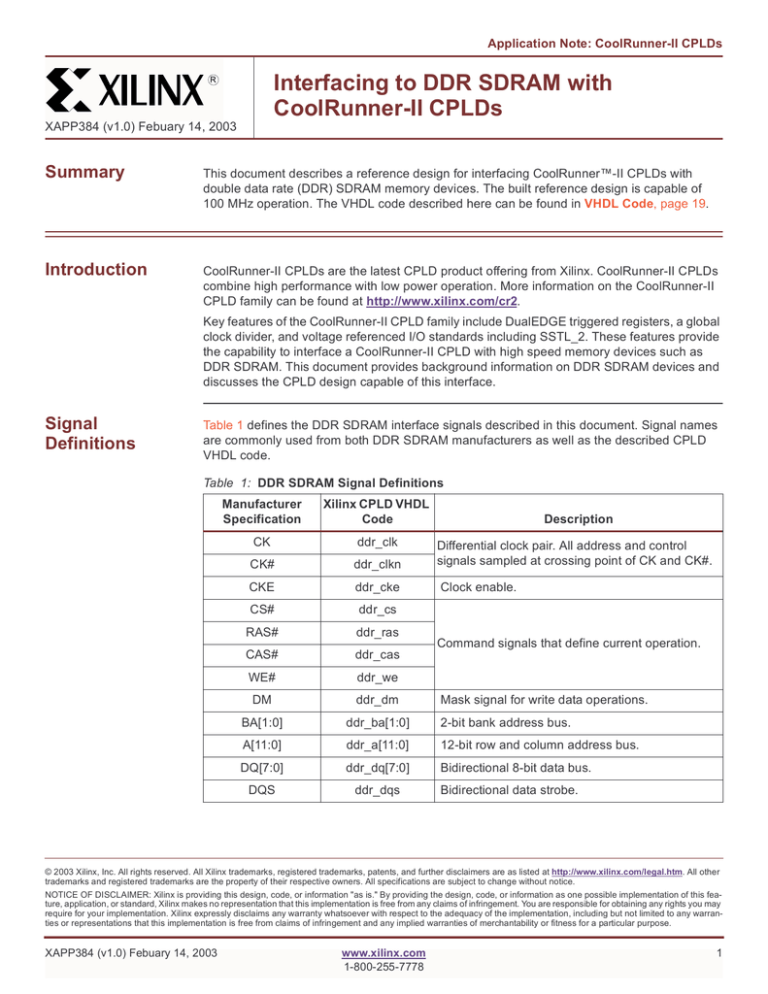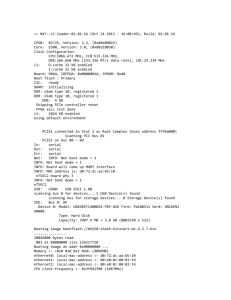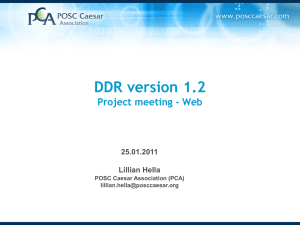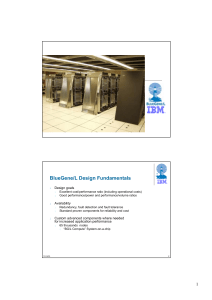
Application Note: CoolRunner-II CPLDs
Interfacing to DDR SDRAM with
CoolRunner-II CPLDs
R
XAPP384 (v1.0) Febuary 14, 2003
Summary
This document describes a reference design for interfacing CoolRunner™-II CPLDs with
double data rate (DDR) SDRAM memory devices. The built reference design is capable of
100 MHz operation. The VHDL code described here can be found in VHDL Code, page 19.
Introduction
CoolRunner-II CPLDs are the latest CPLD product offering from Xilinx. CoolRunner-II CPLDs
combine high performance with low power operation. More information on the CoolRunner-II
CPLD family can be found at http://www.xilinx.com/cr2.
Key features of the CoolRunner-II CPLD family include DualEDGE triggered registers, a global
clock divider, and voltage referenced I/O standards including SSTL_2. These features provide
the capability to interface a CoolRunner-II CPLD with high speed memory devices such as
DDR SDRAM. This document provides background information on DDR SDRAM devices and
discusses the CPLD design capable of this interface.
Signal
Definitions
Table 1 defines the DDR SDRAM interface signals described in this document. Signal names
are commonly used from both DDR SDRAM manufacturers as well as the described CPLD
VHDL code.
Table 1: DDR SDRAM Signal Definitions
Manufacturer
Specification
Xilinx CPLD VHDL
Code
CK
ddr_clk
CK#
ddr_clkn
Differential clock pair. All address and control
signals sampled at crossing point of CK and CK#.
CKE
ddr_cke
Clock enable.
CS#
ddr_cs
RAS#
ddr_ras
CAS#
ddr_cas
WE#
ddr_we
DM
ddr_dm
BA[1:0]
ddr_ba[1:0]
2-bit bank address bus.
A[11:0]
ddr_a[11:0]
12-bit row and column address bus.
DQ[7:0]
ddr_dq[7:0]
Bidirectional 8-bit data bus.
DQS
ddr_dqs
Description
Command signals that define current operation.
Mask signal for write data operations.
Bidirectional data strobe.
© 2003 Xilinx, Inc. All rights reserved. All Xilinx trademarks, registered trademarks, patents, and further disclaimers are as listed at http://www.xilinx.com/legal.htm. All other
trademarks and registered trademarks are the property of their respective owners. All specifications are subject to change without notice.
NOTICE OF DISCLAIMER: Xilinx is providing this design, code, or information "as is." By providing the design, code, or information as one possible implementation of this feature, application, or standard, Xilinx makes no representation that this implementation is free from any claims of infringement. You are responsible for obtaining any rights you may
require for your implementation. Xilinx expressly disclaims any warranty whatsoever with respect to the adequacy of the implementation, including but not limited to any warranties or representations that this implementation is free from claims of infringement and any implied warranties of merchantability or fitness for a particular purpose.
XAPP384 (v1.0) Febuary 14, 2003
www.xilinx.com
1-800-255-7778
1
R
DDR SDRAM
Interfacing to DDR SDRAM with CoolRunner-II CPLDs
DDR SDRAM memory devices provide a migration path from single data rate (SDR) memory
devices for enhanced applications. DDR memory doubles the bandwidth of the device without
increasing the clock speed or bus width. DDR SDRAM provides a source-synchronous data
capture at a rate of twice the clock frequency. These devices utilize a 2n-prefetch architecture
where the internal data bus is twice the size of the external data bus.
The core of a DDR SDRAM is similar to SDR SDRAM with identical address and control
interfaces, bank structures and refresh requirements. The main difference between DDR and
SDR SDRAM is in the actual data interface. SDR is fully synchronous using the positive edge
of the clock. DDR is true source-synchronous and captures data twice per clock cycle with a
bidirectional data strobe, DQS.
Data strobe signals were added to DDR devices to achieve higher data rates. Data strobes are
non-free running signals that are controlled by the device which is driving data signals (e.g.,
DDR SDRAM or the CPLD). During write operations to the DDR, the controller drives the data
strobe, DQS. During read operations, the DDR SDRAM drives DQS.
The following list is a summary of enhancements for DDR devices:
Xilinx Board
Design
•
DDR utilizes a differential pair for the system clock (CK and CK#)
•
Data is transmitted on both positive and negative edges of the clock
•
DDR devices incorporate an on-chip delay locked loop (DLL)
•
Data strobes are added to improve data capture reliability
•
SSTL-2 signaling techniques are used
The reference design board built by Xilinx includes a CoolRunner-II XC2C256-6TQ144 CPLD
and a Micron MT46V16M8 128 Mb DDR SDRAM. Figure 1 illustrates the interface signals
between the CoolRunner-II CPLD and the DDR SDRAM memory device.
CoolRunner-II CPLD
CK
CK#
CKE
CS#
RAS#
CAS#
WE#
DM
BA[1:0]
A[11:0]
DQ[7:0]
DQS
Micron 128 Mb
DDR SDRAM
X384_01_010803
Figure 1: Block Diagram
2
www.xilinx.com
1-800-255-7778
XAPP384 (v1.0) Febuary 14, 2003
Interfacing to DDR SDRAM with CoolRunner-II CPLDs
R
Figure 2 illustrates the constructed reference design board.
Figure 2: CPLD DDR Design Board
Figure 3 shows a block diagram of the reference design board including all external
components to the CPLD and DDR SDRAM. The board was tested with a Micron 128 Mb DDR
SDRAM (MT56V32M8). However, note that most DDR SDRAM devices have identical pinouts,
regardless of the manufacturer. This board was designed such that it could accommodate any
128 Mb DDR SDRAM in a 4 Meg x 8 x 4 bank configuration.
A Micro Linear ML6554 bus termination regulator is used to generate termination voltage (VTT)
and reference voltage (VREF), as required by the SSTL_2 JEDEC standard. The ML6554 is a
switching regulator capable of sourcing or sinking up to 3A of current while regulating an output
VTT and VREF voltages to within 3% or less.
The board also utilizes three National Semiconductor LP3964 regulators to create 1.8V, 2.5V,
and 3.3V power rails from a single 5V external AC adapter input. The 1.8V rail is used to power
the VCC (core) of the CoolRunner-II CPLD. The 2.5V rail is used to power the ML6554 and the
DDR SDRAM. This rail is also used to power I/O Bank #2 of the CoolRunner-II device (all DDR
XAPP384 (v1.0) Febuary 14, 2003
www.xilinx.com
1-800-255-7778
3
R
Interfacing to DDR SDRAM with CoolRunner-II CPLDs
SDRAM interface signals are connected to Bank #2). A 3.3V rail powers I/O Bank #1 of the
CoolRunner-II CPLD. Bank #1 contains clock inputs, miscellaneous buttons, and LED's.
LP3964
LP3964
LP3964
2.5V
VDD
3.3V
1.8V
2.5V
ML6554
VCCIO1
VCC
VCCIO2
Button
Inputs
VTT
OUT
VREF
OUT
VTT
VREF
VREF VDD, VDDQ
VREF
SMB
Connectors
XC2C256-6TQ144
RP
RP
RS
RS
DQ/DQS
MT46V32M8
RP
RS
JTAG Header
3.3V
3.3V
X384_03_010703
Figure 3: Board Block Diagram
SSTL_2 Termination
SSTL_2 stands for Series Stub Terminated Logic for 2.5V, and it was also defined and
standardized within JEDEC. Although SSTL_2 signaling is applicable for many different
applications, SSTL_2 is particularly optimized for the main memory environment, which has
long stubs off the motherboard bus due to the DIMM routing traces.
The SSTL_2 standard is a high speed signaling specification that uses parallel termination
schemes. The use of parallel termination is important, since it allows proper termination of the
bus transmission lines, which reduces signal reflections. This ultimately allows for higher
possible clock rates.
Two choices for implementing the parallel termination scheme are shown in Figure 4 and
Figure 5. In Figure 4, the bus is terminated at the receiver with a single resistor. In Figure 5, the
bus is terminated at both ends (receiver and transmitter) with resistors. These termination
schemes reduce reflections on the bus, which will provide faster rise and fall times, and will
reduce the signal settling time. The SSTL_2 standard allows for both types of termination
schemes.
VT
RP
RS
Z = 50 Ohms
Transmitter
VREF
Receiver
X384_04_010703
Figure 4: Single Ended SSTL_2 Termination
4
www.xilinx.com
1-800-255-7778
XAPP384 (v1.0) Febuary 14, 2003
R
Interfacing to DDR SDRAM with CoolRunner-II CPLDs
VT
RS
VT
RP
RP
RS
Z = 50 Ohms
VREF
VREF
X384_05_010703
Figure 5: Double Ended SSTL_2 Termination
Generally, single-series single-parallel terminations work well with unidirectional signals such
as address and control lines (as shown in Figure 4). For bidirectional signals, such as DQ and
DQS, double-series double-parallel terminations usually produce slightly better results (as
shown in Figure 5). The reference design board follows this model, where all unidirectional
DDR SDRAM signals are single-series single-parallel terminated, and all bidirectional DDR
SDRAM signals are double-series double-parallel terminated.
However, it should be noted, that double-series double-parallel termination schemes require
resistors or resistor packs on both ends of the signal. This approach will undoubtedly increase
component counts, which will also slightly increase board cost. It will also make PC board
layout more difficult. In most applications, a designer will achieve maximum benefits from the
use of a single-series single-parallel termination scheme.
XAPP384 (v1.0) Febuary 14, 2003
www.xilinx.com
1-800-255-7778
5
R
DDR SDRAM
Description
Interfacing to DDR SDRAM with CoolRunner-II CPLDs
Initialization
DDR SDRAMs require specific power up and initialization steps. Operation is not guaranteed
without meeting these requirements. Figure 6 illustrates the initialization steps used in this
reference design for the DDR SDRAM device.
Wait for stable power
and clock inputs
1
NOP
2
3
Precharge all
addresses
Extended Mode Register
Write (Enable DLL)
4
Mode Register Write
(Reset DLL)
5
Wait 200 clock cycles
6
7
Precharge all
addresses
8
Execute Auto Refresh
9
Mode Register Write
(Set CAS & burst)
X384_06_010703
Figure 6: Initialization Sequence
After waiting for power supplies and clock inputs to stabilize (approximately 200 µs), a NOP
operation is performed. In step 3, a PRECHARGE command is issued to all banks in the DDR
SDRAM. Next, a write to the Extended Mode Register is performed to enable the DDR SDRAM
DLL. In step 5, a write to the Mode Register will reset the DLL. For more information on the
Mode Register and Extended Mode Register, refer to Customizing, page 7.
Once the DLL is reset, the controller must wait 200 clock cycles for the DLL to lock. Next, a
PRECHARGE ALL command is issued, placing the device in the all banks idle state. In this idle
state, an AUTO REFRESH command is issued. The last step is a write to the Mode Register to
set operating parameters such as CAS latency and burst length. After all these steps have
been completed, the DDR SDRAM is ready for normal operation.
6
www.xilinx.com
1-800-255-7778
XAPP384 (v1.0) Febuary 14, 2003
R
Interfacing to DDR SDRAM with CoolRunner-II CPLDs
Customizing
The operation of each DDR SDRAM can be customized by writing different values to the mode
register and extended mode register. Each register allows the designer to set parameters for
interfacing with the DDR SDRAM device.
Mode Register
Writing to the mode register allows the user to specify operating parameters. A write is
performed by the controller with a LOAD MODE REGISTER command to the SDRAM. The
data to write into the mode register is read from the address lines during the operation.
The mode register allows the following parameters to be specified:
•
Burst length
•
Burst type
•
CAS latency
•
Operating mode
Extended Mode Register
The extended mode register controls functions beyond the mode register such as DLL
enable/disable and output drive strength. A write to the extended mode register is performed
with a LOAD MODE REGISTER command and asserting the bank address lines (BA1 = 0 and
BA0 = 1).
Operations
Table 2 describes the commands of the DDR SDRAM supported in this reference design.
Table 2: DDR Commands
Command
Description
NOP
Deselect DDR SDRAM. No new commands executed.
LOAD MODE REGISTER
ACTIVE
Defines operating mode of SDRAM.
Opens row in specified bank for access.
READ
Initiates burst read operation.
WRITE
Initiates burst write operation.
BURST TERMINATE
PRECHARGE
Terminates a burst read.
Deactivates open row in specified bank.
AUTO REFRESH
Retains data in SDRAM.
DDR SDRAM is organized in banks, where each bit location can be represented with a row and
column address. Prior to a READ or WRITE instruction, the specified row location must be
opened for access. This is accomplished by issuing an ACTIVE command with the row address
on the address lines of the DDR SDRAM, A[11:0]. Once the row is opened for access, the
READ or WRITE command is issued with the column address on the address lines, A[11:0].
Write Cycle
Due to the source-synchronous nature of the DDR SDRAM interface, the controller must drive
the data strobe, DQS, during a WRITE operation. With the setup and hold time requirements on
XAPP384 (v1.0) Febuary 14, 2003
www.xilinx.com
1-800-255-7778
7
R
Interfacing to DDR SDRAM with CoolRunner-II CPLDs
the DDR data inputs, the data strobe, DQS, must be center-aligned with the data, DQ. The
interface signals associated with a WRITE command are shown in Figure 7.
Figure 7: Write Cycle (from Micron MT45V16M8 data sheet)
Read Cycle
During a read operation, the DDR SDRAM will drive the DQ and DQS signals. The generated
DQS signal is edge-aligned with the data, DQ. Since DQS is edge aligned with DQ, data cannot
be reliably captured with respect to the DQS signal. Schemes such as phase shifting DQS or
using a half-phase or quarter-phase clock are necessary for the controller to reliably capture
data. Figure 8 illustrates the timing when a CAS latency of 2 is implemented with a burst length
of 4.
Figure 8: Read Cycle (from Micron MT45V16M8 data sheet)
Precharge
The PRECHARGE command deactivates the open row in a particular bank or all banks. After
a PRECHARGE, the specific row address must be activated with an ACTIVE command prior to
use. The Micron DDR SDRAM has two types of precharge: Auto and Self. Auto precharge is
done by asserting A[10] during a WRITE or READ operation. Auto precharge will automatically
perform a precharge on the open row after the READ or WRITE operation is complete. Self
8
www.xilinx.com
1-800-255-7778
XAPP384 (v1.0) Febuary 14, 2003
R
Interfacing to DDR SDRAM with CoolRunner-II CPLDs
precharge is a separate command and must be initiated by the controller. Figure 9 illustrates
the PRECHARGE instruction.
Figure 9: Precharge Command (from Micron MT45V16M8 data sheet)
Refresh
The DDR SDRAM requires a periodic REFRESH instruction to maintain data in the SDRAM.
The required interval between REFRESH commands is 15.625 µs. There is also the option to
issue up to eight REFRESH commands every 140.6 µs.
CPLD Design
A CoolRunner-II CPLD is utilized as the controller for interfacing to the Micron DDR SDRAM
memory in this reference design. In addition to interfacing to the DDR SDRAM, the CPLD is
responsible for these functions:
•
Generating test logic for write and read operations
•
Sequencing through the initialization steps of the DDR SDRAM
•
Creating interrupts to issue a refresh command
•
Interfacing to board logic buttons and LEDs
To implement write and read operations, test logic is generated by the CPLD. For the purpose
of modeling a system interface, a LFSR was created in the CPLD. The LFSR data is used by
the CPLD as the data to write into the DDR SDRAM. To model the system address for a 128 Mb
SDRAM, the 23-bit address scheme shown in Table 3 is assumed.
Table 3: System Addressing Scheme
Bit
#
22
21
20
19
18
17
Bank
Address
16
15
14
13
12
11
Row Address
"X"
10
9
8
7
6
5
4
3
2
1
0
Column Address
Load Mode Register
Figure 10 illustrates the main logic blocks in the CPLD. The initialization and test operations are
handled by the command state machine. The command state machine is responsible for
generating the command, data, and address signals to the DDR control logic. The DDR
controller state machine interprets the command and asserts the correct signals to the DDR
XAPP384 (v1.0) Febuary 14, 2003
www.xilinx.com
1-800-255-7778
9
R
Interfacing to DDR SDRAM with CoolRunner-II CPLDs
SDRAM. The DDR logic block is responsible for all DDR control signals, including the
differential clock pair, data signals, and address signals. For more detail on the DDR control
logic, refer to DDR Controller, page 12.
ddr_clk
ddr_clkn
8-bit LFSR
ddr_cke
lfsr_data
ddr_cs
lfsr_clk
ddr_ras
int_cmd
Initialization & Test Logic
(Command
State Machine)
int_data
int_addr
ddr_cas
DDR Control Logic
& State Machine
ddr_we
ddr_dm
8
sys_clk
ddr_dq
ddr_dqs
sys_reset
2
ddr_ba
ddr_a
rd_done
wr_done
init_done
12
8
LED Logic
8
4
led_data_wr
led_data_rd
Status LEDs
X384_10_010703
Figure 10: CPLD Block Diagram
Initialization and Test Logic (Command State Machine)
The requirements for correct power up and initialization of the DDR SDRAM are shown in
Initialization, page 6. The initialization and test logic is implemented in the command state
machine of the CoolRunner-II CPLD. This state machine is shown in Figure 11 and described
in Table 4. The states through WAIT_SEQ are required for proper initialization. The purpose of
the states after WAIT_SEQ is to generate test logic to the DDR SDRAM.
Initialization is complete once the state machine has progressed through to the WAIT_SEQ
state. At this point, the test logic states rely on a test data clock, test_data_clk. This clock is a
low frequency clock at approximately 1 Hz. The low frequency clock is for demonstration
purposes only and allows the user to view the test data written into and read from the DDR
SDRAM on the LED displays. Actual implementation of this DDR controller would not include
the states beyond WAIT_SEQ, as the data would be supplied externally from the CPLD.
Progression of the states in the initialization sequence (up to the WAIT_SEQ state) is done by
reading the state value of the DDR controller state machine, represented by ddr_prs_state
10
www.xilinx.com
1-800-255-7778
XAPP384 (v1.0) Febuary 14, 2003
R
Interfacing to DDR SDRAM with CoolRunner-II CPLDs
signal. Once the DDR controller state machine is executing the current instruction, the next
operation can be performed by the command state machine.
IDLE
reset
reset
MR_WR2
NOP_ST
NOP_MR2
PCHRG_ALL1
ddr_prs_state = PRECHRG_ST
EMR_WR
test_data_clk = '0'
WAIT_SEQ
test_data_clk = '1'
ddr_prs_state = LOAD_MR_ST
CH_LFSR
NOP_EMR
WR_DATA
MR_WR1
ddr_prs_state = ACTIVE_ST
ddr_prs_state = LOAD_MR_ST
NOP_MR1
cnt8_qout < 4
NOP_WR
cnt8_qout < 200
cnt8_qout = 4
cnt8_qout = 200
RD_DATA
PCHRG_ALL2
ddr_prs_state = ACTIVE_ST
ddr_prs_state = PRECHRG_ST
AUTO_RFS1
cnt8_qout < 4
NOP_RD
cnt8_qout = 4
ddr_prs_state = AUTO_RFSH_ST
DONE
test_data_clk = '1'
NOP_RFS1
test_data_clk = '0'
AUTO_RFS2
ddr_prs_state = AUTO_RFSH_ST
NOP_RFS2
X384_11_010703
Figure 11: Command State Machine
XAPP384 (v1.0) Febuary 14, 2003
www.xilinx.com
1-800-255-7778
11
R
Interfacing to DDR SDRAM with CoolRunner-II CPLDs
Table 4 describes the function of each state in the command state machine shown in Figure 11.
The default instruction issued to the DDR controller is a NOP instruction.
Table 4: Command State Machine State Description
State Name
IDLE
NOP_ST
PCHRG_ALL1
Function
No operations executed. Wait for end of reset condition.
Issue NOP operation.
Issue PRECHARGE ALL (banks) operation.
EMR_WR
Issue write to extended mode register with LOAD_MR instruction to
enable DLL.
NOP_EMR
Issue NOP instruction. Wait for end of LOAD_MR instruction.
MR_WR1
Issue write to mode register with LOAD_MR instruction to reset DLL.
NOP_MR1
Issue NOP instruction. Wait for 200 clock cycles to lock DLL.
PCHRG_ALL2
Issue PRECHARGE ALL (banks) instruction.
AUTO_RFS1
Issue AUTO REFRESH instruction.
NOP_RFS1
Issue NOP. Wait after AUTO REFRESH instruction (TRFC)
AUTO_RFS2
Issue AUTO REFRESH instruction.
NOP_RFS2
Issue NOP. Wait after AUTO REFRESH instruction (TRFC)
MR_WR2
Write user options into mode register with LOAD MR instruction.
NOP_MR2
Issue NOP. Wait for end of LOAD MR instruction.
WAIT_SEQ
Wait for rising edge of test clock, test_data_clk.
CH_LFSR
Clock LFSR. Register data to write to DDR.
WR_DATA
Write test data to DDR. Issue WRITE instruction.
NOP_WR
Issue NOP. Wait for end of WRITE burst.
RD_DATA
Issue READ instruction.
NOP_RD
Issue NOP. Wait for end of READ burst.
DONE
Issue NOP. Increment bank address counter. Wait for falling edge of
test clock, test_data_clk.
DDR Controller
The CPLD DDR SDRAM control logic is shown in Figure 12. The DDR control logic includes
the DDR controller state machine, generation of the differential clock pair, and generation of the
address and data signals to the DDR. Figure 12 illustrates the interface between the DDR
controller state machine and other DDR functional blocks in the CPLD.
The DDR controller state machine, DDR_CNTR, is responsible for driving the DDR SDRAM
control signals and internal control signals that represent the instruction currently being
executed. The current command to execute is represented by the int_cmd signal generated
from the command state machine (illustrated in Figure 11). The GEN_CLK component creates
the differential clock pair to the DDR SDRAM, ddr_clk and ddr_clkn. The data interface block
represents the logic to read and write the data (DQ) and data strobe (DQS) signals. The
12
www.xilinx.com
1-800-255-7778
XAPP384 (v1.0) Febuary 14, 2003
R
Interfacing to DDR SDRAM with CoolRunner-II CPLDs
DDR_ADDR block is responsible for assigning the DDR address, ddr_a. The ASSIGN_BA
block is responsible for assigning the DDR bank address lines, ddr_ba.
int_data [15:0]
int_data_rd [15:0]
ddr_dqs
Data
Interface
ddr_dq [7:0]
ddr_clk_int
ddr_clk
GEN_CLK
ddr_read_en
ddr_clkn
ddr_write_en
sys_clk
ddr_clk_int
ddr_cke
ddr_cs
int_cmd [3:0]
ddr_ras
DDR_CNTR SM
ddr_cas
ddr_we
ld_mr
ddr_prs_state
row_addr_en
ddr_dm
int_addr [20:0]
prechrg_en
DDR_ADDR
ddr_a [12:0]
ddr_clk_int
ddr_clk_int
ASSIGN_BA
ddr_ba [1:0]
int_addr [22:21]
x384_12_010703
Figure 12: DDR Control Logic Block Diagram
A detailed description of the DDR controller state machine (DDR_CNTR SM block shown in
Figure 12) is illustrated in Figure 13. The DDR controller state machine remains in the IDLE
state waiting for the next instruction to execute. The next instruction to execute is asserted from
the command state machine and represented in the int_cmd signal. For AUTO REFRESH,
PRECHARGE and LOAD MODE REGISTER instructions, a single state transition occurs.
In this design, auto precharge is utilized. With this assumption, an ACTIVE command must be
issued prior to any READ or WRITE operation. When the DDR controller state machine
XAPP384 (v1.0) Febuary 14, 2003
www.xilinx.com
1-800-255-7778
13
R
Interfacing to DDR SDRAM with CoolRunner-II CPLDs
receives a new READ or WRITE instruction, an ACTIVE command is asserted to the DDR prior
to the READ or WRITE sequence.
PRECHRG_ST
int_cmd = PRECHARGE
int_cmd = AUTO_RFS
LOAD_MR_ST
IDLE
AUTO_RFS_ST
int_cmd = LOAD_MR
int_cmd = READ
or WRITE
ACTIVE_ST
int_cmd = READ
int_cmd = WRITE
WAIT_READ_ST
WAIT_WRITE_ST
WAIT_READ_ST2
WRITE_ST
READ_ST
WRITE_DATA_ST
wr_brst_qout < 2 | 4 | 8
wr_brst_qout = 2 | 4 | 8
cas_qout < 2
CAS_DELAY_ST
WAIT_TWR
cas_qout = 2
READ_DATA_ST
WAIT_TRP
rd_brst_qout < 2 | 4 | 8
rd_brst_qout = 2 | 4 | 8
RD_DONE_ST
X384_13_010703
Figure 13: DDR Controller State Machine
The function of each state in the DDR controller is described in Table 5.
Table 5: DDR Controller State Machine State Description
State Name
IDLE
14
Function
Assert NOP instruction control signals to DDR. Determines next
operation to execute based on the value of int_cmd signal.
AUTO_RFS_ST
Assign DDR command values to execute AUTO REFRESH
instruction. Auto refresh retains data in DDR SDRAM.
PRECHRG_ST
Assign DDR command values to execute PRECHARGE
instruction. Precharge command deactivates specified row in
one bank or all banks.
www.xilinx.com
1-800-255-7778
XAPP384 (v1.0) Febuary 14, 2003
Interfacing to DDR SDRAM with CoolRunner-II CPLDs
R
Table 5: DDR Controller State Machine State Description (Continued)
State Name
Function
LOAD_MR_ST
Assign DDR command to execute LOAD MODE REGISTER.
The mode register or extended mode register can be written to in
this state, determined by bank address, ddr_ba signal.
ACTIVE_ST
Assign DDR command value to execute an ACTIVE command.
Asserts row_addr_en for DDR_ADDR block to assign row
address on ddr_a signal.
WAIT_READ_ST
Execute NOP instruction. Necessary to meet timing specification
for TRCD.
WAIT_READ_ST2
Execute NOP instruction. Necessary to meet timing specification
for TRCD.
READ_ST
Issue READ instruction by assigning DDR signals.
CAS_DELAY_ST
Wait for specified CAS latency of READ operation. Enable CAS
latency counter, cas_cnt_en, is asserted.
READ_DATA_ST
Read data from DDR SDRAM. Assert ddr_read_en signal to data
interface logic block. Enable rd_brst_qout counter. Remain in this
state for length of specified burst to capture all data.
RD_DONE_ST
WAIT_WRITE_ST
WRITE_ST
Done with read operation. Assert rd_done flag for LED logic.
Execute NOP instruction. Necessary to meet timing specification
for TRCD.
Assign WRITE command values to DDR SDRAM to issue
WRITE instruction.
WRITE_DATA_ST
Enable data write to DDR SDRAM by asserting ddr_write_en
signal to data interface logic block. Enable wr_brst_qout counter.
Wait for end of write burst length.
WAIT_TWR
Execute NOP instruction. Necessary to meet timing specification
for write recovery, TWR.
WAIT_TRP
Execute NOP instruction. Necessary to meet timing specification
for precharge command period, TRP.
Clock Generation
The DDR SDRAM must be supplied with a differential clock pair, CK and CK#. This differential
clock pair requirement has been added to DDR devices to increase accuracy caused by clock
XAPP384 (v1.0) Febuary 14, 2003
www.xilinx.com
1-800-255-7778
15
R
Interfacing to DDR SDRAM with CoolRunner-II CPLDs
jitter. DDR SDRAM uses the crossing point of CK and CK# as defined by the JEDEC standard
shown in Figure 14.
Notes:
1. VMP (DC) = Clock Input Mid-Point Voltage
2. VIX (AC) = Clock Input Crossing Point Voltage
3. VID (DC) = Clock Input Differential Voltage
4. VID (AC) = Clock Input Differential Voltage
5. Refer to Micron MT46V16M8 data sheet for more information.
Figure 14: SSTL_2 Clock Requirements (from Micron MT45V16M8 data sheet)
All address and control signals are sampled on the crossing of the positive edge of CK and
negative edge of CK#. Output data (DQ and DQS) is referenced to all crossings of CK and
CK#.
Figure 15 illustrates the CPLD configuration for generating CK and CK#, ddr_clk and ddr_clkn.
The 180 degree phase difference in the clock pair is created with the reset or preset conditions
on the TFF component. The buffers in Figure 15 are shown to illustrate the timing
characteristics of the CoolRunner-II device. For more information on the timing of CoolRunnerII, refer to the CoolRunner-II Timing Model Application Note.
Vcc
T
ddr_clk
Q
OBUF
2.5V OUT
sys_clk
3.3V IN
GCK
RST
Vcc
T
ddr_clkn
Q
OBUF
2.5V OUT
sys_clk
3.3V IN
GCK
X384_15_010703
PRE
Figure 15: CPLD Clock Generation
16
www.xilinx.com
1-800-255-7778
XAPP384 (v1.0) Febuary 14, 2003
R
Interfacing to DDR SDRAM with CoolRunner-II CPLDs
Clock Timing
Figure 16 illustrates the timing characteristics for the CPLD clock generation. This design
utilizes the system clock, sys_clk, as the 2x input clock. The DDR differential clock pair, ddr_clk
and ddr_clkn, are generated using the rising edge of sys_clk thereby creating a 1x clock output.
T= 7.5ns
(133 MHz)
sys_clk
ddr_clk
ddr_clkn
T= 15 ns
(66.67 MHz)
tCO = 5 ns
X384_16_010703
Figure 16: Clock Timing
The generation of the differential clock pair, ddr_clk and ddr_clkn, is based on an asynchronous
delay through the CPLD. Due to the propagation delay in creating ddr_clk and ddr_clkn, a
phase difference is induced between the differential clock pair and the 2x system clock,
sys_clk. This delta is labeled as TCO in Figure 16. The delay accrued in generating ddr_clk and
ddr_clkn will vary due to several factors. One factor is the target size and speed grade
CoolRunner-II device. Each CoolRunner-II device will have different characteristics based on
density and timing characteristics. Other factors such as temperature variance, supply voltage,
and process variation will effect TCO in creating the differential clock pair.
Read Operation
The CPLD design described here does not utilize the data strobe, DQS, during READ
operations. Instead, the clock domain is utilized to capture data in a READ cycle. In a READ
instruction, the DDR SDRAM drives the data signals, DQ, and the data strobe, DQS. The CPLD
is responsible for capturing the data. The data strobe, DQS, is edge-aligned with the data, DQ.
The valid window for a single data bit is from one CK/CK# edge to the next. Compensation due
to process and environment must be accounted for with multiple DQ signals. The DDR SDRAM
device specifies an access time, tAC, for which all data bits are valid. To calculate setup and
hold times, TAC (MAX) and TAC (MIN) are used to determine the timing budget. The following
shows the equation for the data valid window.
DVW = 1/2 * TCK – TAC (MAX) + TAC (MIN)
The parameter, TCK represents the period of the DDR clock. For example, with a 66.67 MHz
DDR clock, TCK = 15 ns. In this design, the DVW = 6 ns.
Figure 17 illustrates how the 2x clock, sys_clk, is used to capture data in the data valid window
for READ operations. Point A represents when the CPLD captures the first data byte, D 0, from
XAPP384 (v1.0) Febuary 14, 2003
www.xilinx.com
1-800-255-7778
17
R
Interfacing to DDR SDRAM with CoolRunner-II CPLDs
the DDR SDRAM. At point B, the second byte, D 1, (in a burst of 2) is captured and registered
into the CPLD.
A
B
sys_clk
ddr_clk
ddr_clkn
DQ [7:0]
D0
D1
DQS
T = 6 ns
DVW
X384_17_010703
Figure 17: Data Valid Window
Device Utilization
The DDR reference design board utilizes a CoolRunner-II XC2C256-6TQ144 device. The DDR
controller, initialization and test logic fits into this device with the utilization results shown in
Table 6.
Table 6: CoolRunner-II Board Design Utilization
Parameter
Processor
Interface
Used
Available
% Utilization
I/O Pins
56
118
47%
Macrocells
208
256
81%
Product Terms
441
896
49%
Registers
187
256
73%
Function Block Inputs
361
640
56%
The DDR SDRAM design described in this document includes the high level control logic that
would normally be the responsibility of a system processor. The high level logic in this CPLD
design includes the initialization functions and test logic generation. These functions are
typically controlled by a system processor. In this type of application, the system design would
be as illustrated in Figure 18.
CoolRunner-II CPLD
Address
Microprocessor
Data
Control
Address
Microprocessor
Interface
Register
Set
DDR
SDRAM
Interface
Data
Control
DDR
SDRAM
X384_18_010703
Figure 18: Application Design Block Diagram
18
www.xilinx.com
1-800-255-7778
XAPP384 (v1.0) Febuary 14, 2003
R
Interfacing to DDR SDRAM with CoolRunner-II CPLDs
The processor connects to the CPLD via a register set. The CPLD is an addressable module on
the processor system bus. An example CPLD register set is shown in Table 7 and provides the
communication link between the DDR SDRAM interface of the CPLD and the microprocessor.
Table 7: Example Register Set
Register
Function
Status Register
Provides status to processor such as done, data ready, and/or
interrupts pending.
Control Register
Sets up parameters such as interrupt enables, clock divisors,
clock phases and polarities, and/or start/stop of data transfers.
Data Input Register
Data to DDR SDRAM from processor during a write operation.
Data Output Register
Data from DDR SDRAM in a processor read operation.
For more information on creating a custom microprocessor or microcontroller interface, refer to
application notes: XAPP349 and XAPP388 found on http://www.xilinx.com.
Device Utilization
Table 8 illustrates the utilization numbers for a stand alone implementation of the DDR
controller targeted to a CoolRunner-II 128 macrocell device.
Table 8: CoolRunner-II DDR Design Utilization
Parameter
VHDL Code
Used
Available
% Utilization
I/O Pins
78
100
78%
Macrocells
60
128
47%
Product Terms
138
448
31%
Registers
50
128
39%
Function Block Inputs
103
320
32%
THIRD PARTIES MAY HAVE PATENTS ON THE CODE PROVIDED. BY PROVIDING THIS
CODE AS ONE POSSIBLE IMPLEMENTATION OF THIS DESIGN, XILINX IS MAKING NO
REPRESENTATION THAT THE PROVIDED IMPLEMENTATION OF THIS DESIGN IS FREE
FROM ANY CLAIMS OF INFRINGEMENT BY ANY THIRD PARTY. XILINX EXPRESSLY
DISCLAIMS ANY WARRANTY OR CONDITIONS, EXPRESS, IMPLIED, STATUTORY OR
OTHERWISE, AND XILINX SPECIFICALLY DISCLAIMS ANY IMPLIED WARRANTIES OF
MERCHANTABILITY, NON-INFRINGEMENT, OR FITNESS FOR A PARTICULAR PURPOSE,
THE ADEQUACY OF THE IMPLEMENTATION, INCLUDING BUT NOT LIMITED TO ANY
WARRANTY OR REPRESENTATION THAT THE IMPLEMENTATION IS FREE FROM
CLAIMS OF ANY THIRD PARTY. FURTHERMORE, XILINX IS PROVIDING THIS
REFERENCE DESIGN "AS IS" AS A COURTESY TO YOU.
XAPP384 - http://www.xilinx.com/products/xaw/coolvhdlq.htm
Conclusion
CoolRunner-II CPLD features such as DualEDGE triggered flops and clock divider make them
the ideal target device for interfacing with DDR SDRAM memory.
References
•
Double Data Rate (DDR) SDRAM. Micron Technology, Inc. 2001.
•
TN-46-05. General DDR SDRAM Functionality. Micron Technology, Inc. 2001.
XAPP384 (v1.0) Febuary 14, 2003
www.xilinx.com
1-800-255-7778
19
R
Revision
History
20
Interfacing to DDR SDRAM with CoolRunner-II CPLDs
The following table shows the revision history for this document.
Date
Version
02/05/03
1.0
Revision
Initial Xilinx release.
www.xilinx.com
1-800-255-7778
XAPP384 (v1.0) Febuary 14, 2003





